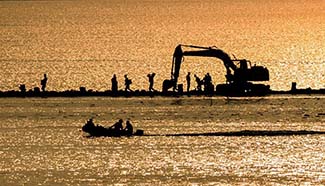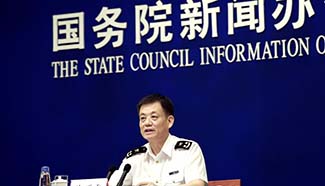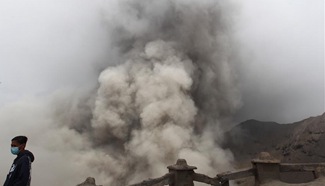
(Xinhua photo)
NANJING, July 13 (Xinhua) -- When Japanese explorer Takeji Miyoshi's expedition dropped anchor near a small island in the South China Sea on Aug. 19, 1933, they were received by three Chinese fishermen.
Takeji's diary entry stated that the fishermen had built houses on Beizi (Northeast Cay), one of the Nansha Islands, which are also known as the Spratly chain. The fishermen offered to show the crew around the island.
Following this first interaction with Chinese residents, Takeji Miyoshi discovered it was not a chance meeting, as he explored the area he found that many of the other islands were home to groups of Chinese fishermen.
He wrote that a large number of fishermen from Hainan had relocated to the small islands in the South China Sea. His team kept detailed records on the daily lives of the fishermen, who called these islands home. Their archives include information on agriculture cultivation and a birth register.
Hu Zhuoran, a member of the Modern History Association in east China's Jiangsu Province, has been researching Miyoshi's documents.
He said that the Japanese had collected lots of details on Chinese inhabitants of the Nansha Islands.
"The archives show that Chinese actually lived on and explored the islands. They were settled," Hu said.
The central government on Tuesday refused to recognize an tribunal award issued on the South China Sea, which denied China's territorial sovereignty on the sea.
The award by the Permanent Court of Arbitration in The Hague stated that all of the "features" in the Spratly chain mean the islands are legally "rocks."
The Philippines sought the arbitration from the tribunal on several issues related to its territorial disputes with China.
The Spratly chain is known as the Nansha Islands to China.
The Japanese explorer, in his ledger, said that his expedition team saw anti-Japanese posters across the island of Zhongye.
The posters were related to the Japanese invasion of northeast China in 1931.
Hu Dekun, head of the China Institute of Boundary and Ocean Studies with the Wuhan University, said that records show that in 1939, Japan occupied all of the Xisha and Nansha islands.
After the World War II, China recovered its sovereignty and jurisdiction over the islands in compliance of the Cairo Declaration, which states that "the territories stolen by Japan from China should be returned to China."
In 1948, an official Chinese map of the South China Sea was released to the International Community. None of the countries in the sea area objected to China's nine-dashed line demarcation.
Hu pointed out that before the Philippines gained independence in 1946, America had not recognized Nansha Islands as Philippine territory.
In 1970s, the Philippines illegally occupied the islands. As a smoke screen, it described the largest island, Taiping Island, as a "rock", in a rejection of China's sovereignty over the island and its surrounding waters.
The "rock," however, had six freshwater wells and lush vegetation when China recovered it from Japan.
According to Japanese archives, during its occupation of Taiping Island, Japanese mined phosphate, and it was home to over 600 people.
Hu said there was plenty of evidence showing the Nansha Islands and its adjacent waters to be Chinese territory. The Chinese people were the first to name and develop the islands and it was the Chinese government that first asserted sovereignty over them.











